Prickly ash is a natural herbal supplement that has been used to treat a myriad of conditions and injuries for thousands of years. This perennial plant can be grown as either a tree or a shrub, making it a great survival garden addition for preppers no matter where they live.
Prickly ash is commonly referred to as the toothache tree, pepper wood, northern prickly ash, Chuan jiao, yellow wood, and the clavalier. It is from the Rue plant family – Rutaceae genus. An Asian version of the prickly ash tree is called crow ash.
Both the bark and the fruit berries from the prickly ash tree and shrub have been used to make natural home remedies.
Related: 23 Medicinal Plants the Native Americans Used on a Daily Basis
History of Prickly Ash
Native American tribes infused prickly ash bark to treat a plethora of medical conditions, ranging from minor to severe.
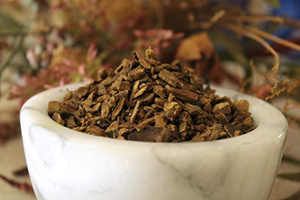
Some of the ailments prickly ash bark infusion was used to treat include: back pain, fever, dry and itchy skin, sore throat, common cold symptoms, colic in infants, lung problems, toothache, post-labor pain in women, and stomach cramps.
Algonquin tribe members mixed roughly two quarts of water with two cups of either dried or fresh prickly ash berries and simmered it over an open flame for approximately one hour. Then, the Native American tribe members would consume the hot tea to lather themselves up into an intense sweat before soaking in a stream.
The tribe members used this regimen to bring relief to stiff joints, back pain, rheumatism, and arthritis pain as well as muscle paralysis fatigue.
Chippewa tribe members were known to make a prickly ash tea not only to drink, but also to soak the feet and legs of the ill or weak elderly and young in, to help strengthen muscles, tendons, joints, and ligaments.
In the 19th century book, American Herbal Medicine, Charles Millspaugh declared prickly ash to be a natural remedy for typhoid, cholera, pneumonia, and typhus, among other serious medical conditions. Millspaugh went on to state that prickly ash acted so rapidly it could be compared to electricity. “I consider prickly ash to be superior to any form of medication that I know of”, Charles Millspaugh wrote.
Some doctors from the 19th century used prickly ash in medications designed to treat nervous and digestive system problems. They would replace cayenne pepper with prickly ash in remedies, because they felt it offered a longer lasting result.
Related: 26 Ancient Remedies That We Lost to History
How to Identify a Prickly Ash Tree
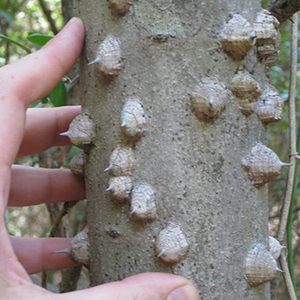 This healing tree grows naturally in great abundance in Missouri and is also frequently found or cultivated in many regions throughout the eastern regions of the United States and Canada.
This healing tree grows naturally in great abundance in Missouri and is also frequently found or cultivated in many regions throughout the eastern regions of the United States and Canada.
Prickly ash trees can grow to reach heights of 26 feet tall. It has deep brown branches that boast up to half inch thick prickles, hence its name.
The unusual look of the prickly ash tree makes it easy to identify, but this healing tree also boasts an equally uncommon scent. If you happen upon one of these healing shrubs or trees, the first thing you might notice is the intense scent of lemon.
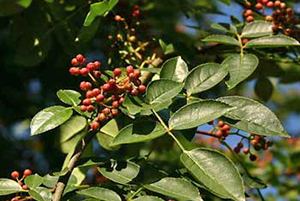 The twigs on branches boast red and rather wooly buds, followed by flowers in shades of greenish yellow each spring.
The twigs on branches boast red and rather wooly buds, followed by flowers in shades of greenish yellow each spring.
Darker green leaves appear as the seasons goes on. The fruit from the prickly ash tree ripens during the late days of summer, going from green to a shade of reddish brown once they mature.
Prickly ash trees and bushes are typically found in densely wooded areas, in or adjacent to damp ravines, and in thickets along the forest edge. Sometimes prickly ash trees can also be found in fields and along rocky ridges, as well. It is a hardy plant that can survive – and thrive, in extremely diverse types of environment.
Health Benefits of Prickly Ash
Prickly ash counts nitrogen producing alkaloids among its compounds. These compounds produce physiological actions and reactions. Some examples of the types of alkaloids that prickly ash contain include quinine, alkamide, and morphine. The numbing properties of alkamide are likely why prickly ash garnered the toothache tree moniker.
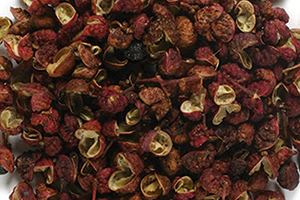 The fruit produced by the prickly ash tree contains volatile oil compounds that may have various medicinal uses. These volatile oils can stimulate bodily tissues and cause dilation in the veins to enhance blood circulation.
The fruit produced by the prickly ash tree contains volatile oil compounds that may have various medicinal uses. These volatile oils can stimulate bodily tissues and cause dilation in the veins to enhance blood circulation.
When the oils from prickly ash fruit are rubbed onto the skin it causes a reddening, because the oils dilate small blood vessels just beneath the surface.
When these same oils are used internally, a similar effect is caused to both the entire circulatory and digestive systems.
Prickly ash is thought to help promote the flow of blood through the body. Because both rheumatism and arthritis stem from problems with joint, muscle, or ligament inflammation and related pain, prickly ash’s possible ability to increase blood flow could be highly beneficial in curtailing discomfort and swelling. Peripheral blood flow transports essential nutrients to joints, discs, and cartilage tissue to help repair damage.
Top 20 Health Benefits of Prickly Ash:
- Toothache
- Rheumatism
- Arthritis
- Digestive Aid
- Lymphatic Stimulant
- Gas Relief
- Ulcers
- Muscle Liniment Active Ingredient
- Fever
- Circulatory System Stimulant
- Anti-fungal Cleanser.
- Post-Childbirth Pain
- Blood Pressure Issues
- Body Invigorating Tonic
- Sialagogue (to treat dry mouth)
- Minor Wounds
- Cytotoxin (an agent that can be toxic to destructive cells, like cancer cells)
- Varicose Veins
- Leg Cramps
- Raynaud’s Syndrome
Prickly Ash Usage
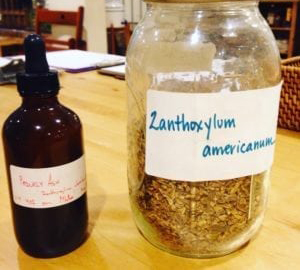 When taking prickly ash to soothe an aching tooth, soak a piece of clean cotton cloth or a cotton ball in the tincture and gently apply it directly to the tooth.
When taking prickly ash to soothe an aching tooth, soak a piece of clean cotton cloth or a cotton ball in the tincture and gently apply it directly to the tooth.
You could also use powdered prickly ash bark sprinkled lightly on a small piece of bread that has peanut butter on it – the powder sticks to the peanut butter. The peanut butter and bread is then wrapped around the tooth like a bandage.
In a survival situation, or for the sake of making a simple and quick natural toothache remedy, simply gently gnaw or suck on a piece of clean bark.
To treat dry mouth with prickly ash to induce the production of saliva, sprinkle a pinch of prickly ash bark powder under your tongue and allow it to dissolve. You might need to repeat this regimen every couple of hours, to prevent the dry mouth from presenting again.
To brew prickly ash into a tea, simmer two teaspoons of bark (either fresh or preserved) in hot water for approximately 15 to 20 minutes. Typically, prickly ash settles better on the stomach and might be most effective when taken right before eating a meal.
Prickly Ash Dosage
Typically, prickly ash is infused into a tincture, powder, or oil for human use. According to the Chrysalis Natural Medicine Clinic guide, adults should take between 250 to 750 milligrams up to three times per day.
If making a prickly ash home remedy yourself, simmering 1 teaspoon of chopped bark in water for roughly 20 minutes to make a decoction for adults to consume up to three times per day is recommended. When taking prickly ash in tincture form, the recommended adult dosage is between 10 to 20 drops, taken up to three times per day.
Related: How To Make Your Own Herbal Tincture
Prickly Ash Storage
Your homemade or store bought prickly ash natural herbal supplement should be stored in an airtight container, away from both direct sunlight and heat – but not in a damp or humid place.
When exposed to both dampness or humidity and heat, prickly ash’s compounds will break down more quickly and make it far less effective in battling health issues.
Prickly Ash Side Effects
Because few studies have been conducted on the potential health benefits of prickly ash, there is little evidence available about possible side effects, as well. It is a relatively accepted assertion that individuals who use prickly ash can experience sunlight sensitivity and experience sunburn far more easily.
Simply because a home remedy comes from nature does not mean it is safe for everyone to use. Possible signs of experiencing a prickly ash allergic reaction include skin rash, hives, tightness of chest and/or throat, chest pain, shortness of breath.
Prickly ash is not recommended for folks with the following medical conditions: Crohn’s Disease, ulcerative colitis, GI tract infections, GI medical conditions, peptic ulcer, gastroesophageal reflux, Irritable Bowel Syndrome.
Individuals taking a blood thinner medication, stomach acid reduction medication, cardiac disease, or high blood pressure medicines also should not use prickly ash.
I am not a medical professional of any type. This information is shared from my personal experience and research. Always consult with your doctor before embarking on any type of natural herbal medicine routine.
You may also like:
30 Survival Uses for Wood Ashes You Never Thought of
The U.S. Army’s Forgotten Food Miracle (Video)
How To Use The Old Cupping Method To Get Rid Of Back Pain
9 Natural Remedies that People with Diabetes Will Find Useful


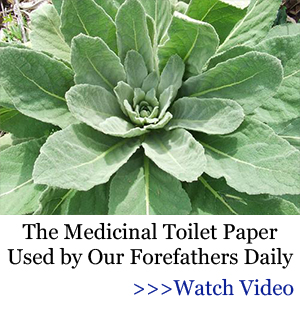














Not mentioned in the article is, the limbs from a Prickly Ash (tickle tongue) tree can be used as a weapon. If you have ever been hit with the thorns, I think you would agree that most people would give you a wide berth…
The pictures shown look nothing like the “Tickle Tongue” we, as kids, would sometimes put in our mouths to experience the numbing, tickling effect of the leaves and bark. My brothers always told me the correct name for that bush/tree was Prickly Ash. I can still take you to the same bush of it growing beside the watering tank on the ranch managed by my late grandfather near Menard, TX back in the 50s. (The Clark Ranch)
In Texas we have “cat claw” Which is similar in that it has the bumps and stickers that look like a cats claw.
Great information. This could be a thing, start doing herbs with their medicinal properties, or have you been doing this and Ive been in the dark?
Like to know more, highly interested in what plants can do for you.
And thank-You about the prickly ash❣
From the Wikipedia: Sichuan pepper (Chinese: 花椒; pinyin: huājiāo)[1] is a spice from the Sichuan cuisine of China’s southwestern Sichuan Province. It has a unique aroma and flavor that is neither hot like chili peppers nor pungent like black pepper. Instead, it has slight lemony overtones and creates a tingly numbness in the mouth due to hydroxy-α-sanshool. It is commonly used in Sichuanese dishes such as mapo doufu and Chongqing hot pot, and is often added together with chili peppers to create a flavor known in Mandarin as málà (麻辣; “numb-spiciness”).
Despite its name, Sichuan pepper is not closely related to either black pepper or the chili pepper. It comes from the seeds of at least two species of small trees in the global genus Zanthoxylum (colloquially known as “prickly ash”) in the family Rutaceae, which includes citrus and rue. The husk or hull (pericarp) around the seeds may be used whole, especially in Sichuan cuisine, and the finely ground powder is one of the ingredients for five-spice powder. Related species are used in the cuisines of Tibet, Bhutan, Nepal, Thailand, the Konkani and Kumaoni people of Northeast India, and the Toba Batak of Indonesia.
Coolest tree ever.
Looking to add prickly ash bark (or berries) to a pain relief topical rub on..for dental & joint pain
Does anyone know if its best to use berries or bark for this purpose?
Also is an alcoholic tincure or an infused oil best for topical use?
Additionally any recipes, or referrals to old books and/or articles where there are recipes would be much appreciated.
Thankyou
Freddie